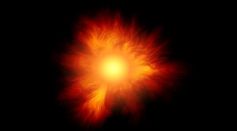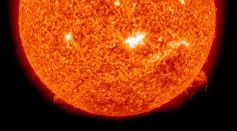Tags: Space Weather
Northern Lights To Be Visible in Much of US Due to Powerful Space Weather Condition; How Can G5 Storm Trigger This Cosmic Spectacle?
Space Weather Alert: NOAA Warns of a Solar Radiation Storm With 60% Chance of Hitting the Earth This Week

Gargantuan Sunspot 15 Times Wider Than Earth Erupts With Massive X-Class Solar Flare Causing Radio Blackouts
UAF Lidar Designed to Measure Neutrally Charged Iron Atoms in the Atmosphere Shows Potential in Understanding Space Weather That Surrounds Earth

Predicting Space Weather Now Made Easier

Solar Flares Could Cause Train Delays Due to Signal Failures, Crippling Railway System in UK
Cluster of Sunspots 15 Times the Earth’s Size May Send Solar Storm This Weekend

Severe Space Weather Disrupts Birds’ Navigational Skills, Leads Them off Course During Migrations
Strong Solar X-Flare Knocks Out Radio Transmission Across North America, Prompts Space Weather To Issue Warnings Due to Particles Hitting Earth

Space Weather Resilience: Role of International Cooperation and Research To Prepare the World for Solar Storms

Space Weather Research: Advancements and Breakthroughs

Lunar Weather Explained: NASA Scientist Describes How the Conditions of the Sun Affects the Moon

Space Weather Causes Explained in a 3 cm Sphere Glass That Replicates Gravity of Other Planets
Green Comet Captured Losing Part of Its Tail Due to Solar Storm [Photo]

Internet Shutdown on Earth; How Does a Massive Solar Storm Contribute to the Online Interruption in Space?

Aurora Borealis Forecast Dashboard: When and Where Can You See the Northern Lights?
Mars' 2nd Type of Aurora Described As ‘Patchy' and ‘Chaotic’ Protecting Planet From Solar Wind
Space Weather is Now Easier to Predict and New Australian Satellite is Here to Help
Solar Storms Mystery Finally Solved: Simulation Model to Predict Space Weather, Geomagnetic Storms Developed
Solar Wind, Space Weather Poses Threats to Technology? Experts Study Direction of Winds on Sun's Surface
Most Popular

Ancient Hotspot Found to Have Created Great Lakes 300 Million Years Ago

Mysterious Structures Discovered Beneath the Pacific Ocean, Puzzle Scientists

Health Benefits of Drinking Hot Chocolate

Largest Known Volcanic Aquifer Discovered Beneath Oregon's Cascades





